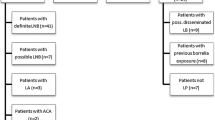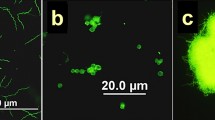Abstract
Sera collected from healthy individuals from the general population in the Czech Republic during repeated cross-sectional surveys were analyzed. Samples collected in the same six districts in two time periods, 1978–1989 and 2001, were compared. The study subjects were divided into six age categories between 10 and 59 years. Overall, 434 samples from 1978–1989 and 270 samples from 2001 were screened for Anaplasma phagocytophilum (AP) and Borrelia burgdorferi sensu lato (BB). The antiAP positivity rates were 13.1% and 11.5% in the first and second period, respectively, and did not differ significantly between the periods (P = 0.559). The anti-BB antibodies were detected in 33.9% and 14.8% of study subjects, respectively. The positivity rates were significantly lower in the second period (P>0.001). No considerable changes were observed in the sex distribution of positive findings between the two periods. The highest positivity rates of anti-AP antibodies were found in the 10–14 year age group: 16.0% in 1978–1989 and 16.7% in 2001. The age distribution of the anti-AP antibody positivity rates did not change substantially (P = 0.872). In 1978–1989, the lowest anti-BB antibody positivity rate (26.7%) was found in the 10–14 year age group, with a gradual increase with age to 41.1% in 50–59 year-olds. In 2001, the positivity rate in the 10–14 year age group was 26.2% and was not significantly different from that in the first period (P = 0.955). However, the positivity rates in the older age groups 15–59 years decreased significantly (P<0.001) and varied between 8.3% and 15.1%.
Similar content being viewed by others
References
Aguero-Rosenfeld M.E., Kalantarpour F., Baluch M., Horowitz H.W., McKenna D.F., Raffalli J.T., et al. 2000. Serology of culture-confirmed cases of human granulocytic ehrlichiosis. Journal of Clinical Microbiology, 38, 635–638
Bakken J.S., Dumler J.S. 2006. Clinical diagnosis and treatment of human granulocytotropic anaplasmosis. Annals of the New York Academy of Sciences. 1078, 236–247. DOI: 10.1196/annals.1374.042
Balátová P., Kurzová Z., Hulínská D. 2011. Sérologie lymeské borreliózy a humánní granulocytární ehrlichiózy v letech 2005–2010. Epidemiologie, Mikrobiologie, Imunologie, 60, 74–76
Bartůnĕk P., Mrázek V., Varejka P., Sklenár T., Bína R., Listvanová S., Janovská D. 2000. Výpovědní hodnota prevalence antiboreliových protilátek u zdravé a rizikové populace. Epidemiologie, Mikrobiologie, Imunologie, 49, 4–10
Basta J., Plch J., Hulínská D., Daniel M. 1999. Incidence of Borrelia garinii and Borrelia afzelii in Ixodes ricinus ticks in an urban environment. European Journal of Clinical Microbiology & Infectious Diseases, 18, 515–517. DOI: 10.1007/s100960050335
Bazovská S., Guryčová D., Výrosteková V., Jareková J., Bakoss, P., Macháčová, E., Špaleková, M. 2010. Protilátky proti pôvodcom niektorých prírodne ohniskových nákaz v sérach darcov krvi zo západného Slovenska. Epidemiologie, Mikrobiologie, Imunologie, 59, 168–171
Biesiada G., Czepiel J., Leśniak M.R., Garlicki A., Mach T. 2012. Lyme disease: review. Archives of Medical Science, 8, 978–982. DOI: 10.5114/aoms.2012.30948
Chochlakis D., Papaeustathiou A., Minadakis G., Psaroulaki A., Tselentis Y. 2008. A serosurvey of Anaplasma phagocytophilum in blood donors in Crete, Greece. European Journal of Clinical Microbiology & Infectious Diseases, 27, 473–475. DOI: 10.1007/s10096-007-0457-3
Danielová V., Daniel M., Rudenko N., Golovchenko M. 2004. Prevalence of Borrelia burgdorferi sensu lato genospecies in hostseeking Ixodes ricinus ticks in selected South Bohemian locations (Czech Republic). Central European Journal of Public Health, 12, 151–156
Denis D.T., Hayes E.B. 2002. Epidemiology of Lyme borreliosis. In: (Eds. J. Gray, O. Kahl, R.S. Lane and G. Stanek) Lyme borreliosis: Biology, epidemiology and control. CABI Publishing, Oxford, 251–280. DOI: 10.1079/9780851996325.0000
Dessau R.B., Bangsborg J.M., Ejlertsen T., Skarphedinsson S., Schønheyder H.C. 2010. Utilization of serology for the diagnosis of suspected Lyme borreliosis in Denmark: survey of patients seen in general practice. BMC Infectious Diseases, 10, 317. DOI: 10.1186/1471-2334-10-317
Dvořáková-Heroldová M., Dvořáčková M. 2014. Séroprevalence Anaplasma phagocytophilum u pacientů se suspektní lymeskou borreliózou. Epidemiologie, Mikrobiologie, Imunologie, 63, 297–302
Esposito S., Bosis S., Sabatini C., Tagliaferri L., Principi N. 2013. Borrelia burgdorferi infection and Lyme disease in children. International Journal of Infectious Diseases, 17, 153–158. DOI: 10.1016/j.ijid.2012.09.014
Feder H.M., Jr, Gerber M.A., Luger S.W., Ryan R.W. Persistence of serum antibodies to Borrelia burgdorferi in patients treated for Lyme disease. Clin Infect Dis. 1992 Nov; 15, 788–93
Glatz M., Golestani M., Kerl H., Müllegger R.R. 2006. Clinical relevance of different IgG and IgM serum antibody responses to Borrelia burgdorferi after antibiotic therapy for erythema migrans: long-term follow-up study of 113 patients. Archives of Dermatology. 142, 862–868. DOI: 10.1001/archderm.142.7.862
Grubhoffer L., Golovchenko M., Vancová M., Zacharovová-Slavícková K., Rudenko N., Oliver J.H. Jr. 2005. Lyme borreliosis: insights into tick-/host-borrelia relations. Folia Parasitologica. 52, 279–294
Grzeszczuk A., Stańczak J., Kubica-Biernat B., Racewicz M., Kruminis-Łozowska W., Prokopowicz D. 2004. Human anaplasmosis in north-eastern Poland: seroprevalence in humans and prevalence in Ixodes ricinus ticks. Annals of Agricultural and Environmental Medicine, 11, 99–103
Gustafson R., Svenungsson B., Gardulf A., Stiernstedt G., Forsgren M. 1990. Prevalence of tick-borne encephalitis and Lyme borreliosis in a defined Swedish population. Scandinavian Journal of Infectious Diseases, 22, 297–306
Gustafson R., Forsgren M., Gardulf A., Granström M., Svenungsson B. 1993. Antibody prevalence and clinical manifestations of Lyme borreliosis and tick-borne encephalitis in Swedish orienteers. Scandinavian Journal of Infectious Diseases, 25, 605–611
Hájek T., Libiger J., Janovská D., Hájek P., Alda M., Höschl C. 2006. Clinical and demographic characteristics of psychiatric patients seropositive for Borrelia burgdorferi. European Psychiatry, 21, 118–122. DOI: 10.1016/j.eurpsy.2004.09.021
Hammers-Berggren S., Lebech A.M., Karlsson M., Svenungsson B., Hansen K., Stiernstedt G. 1994. Serological follow-up after treatment of patients with erythema migrans and neuroborreliosis. Journal of Clinical Microbiology, 32, 1519–1525
Hubálek Z. 2009. Epidemiology of lyme borreliosis. Current Problems in Dermatology, 37, 31–50. DOI: 10.1159/000213069
Hulínská D., Votýpka J., Vaňousová D., Hercogová J., Hulínský V., Drevová H., Kurzová Z., Uherková L. 2009. Identification of Anaplasma phagocytophilum and Borrelia burgdorferi sensu lato in patients with erythema migrans. Folia Microbiologica. 54, 246–256. DOI: 10.1007/s12223-009-0039-0
Jirous J., Pokorný J., Zástĕra M., Doutlík S., Bojar M. 1988. First experience with ELISA serosurvey for tick-borne borreliosis (Lyme disease) in Czechoslovakia. Journal of Hygiene, Epidemiology, Microbiology, and Immunology, 32, 169–172
Krbkova L., Stanek G. 1996. Therapy of Lyme borreliosis in children. Infection, 24, 170–173
Kriz B., Hubalek Z., Maly M., Daniel M., Strakova P., Betasova L. 2015. Results of the screening of tick-borne encephalitis virus antibodies in human sera from eight districts collected two decades apart. Vector-Borne and Zoonotic Diseases, 15, 489–493. DOI: 10.1089/vbz.2014.1747
Lásiková S., Moravcová L., Pícha D., Holečková D., Žďárský E. 2004. Detekce antiehrlichiových protilátek a přímý průkaz ehrlichiové nukleové kyseliny polymerázovou řetězovou reakcí (PCR) u pacientů v České republice. Klinická mikrobiologie a infekční lékařství,10, 25–29
Lotrič-Furlan S., Petrovec M., Avsic-Zupanc T., Logar M., Strle F. 2002. Epidemiological, clinical and laboratory distinction between human granulocytic ehrlichiosis and the initial phase of tick-borne encephalitis. Wiener klinische Wochenschrift, 114, 636–640
Ongut G., Ogunc D., Mutlu G., Colak D., Gultekin M., Gunseren F., Donmez L., Tuncer D. 2006. Seroprevalence of antibodies to Anaplasma phagocytophilum in Antalya, Turkey. Infection, 34, 107–109. DOI: 10.1007/s15010-006-5040-9
Pazdiora P., Topolčan O., Benešová J., Böhm K., Brejcha O., Kubátová A., et al. 1994. Surveillance lymské boreliózy v Západočeském kraji, výskyt protilátek u pracovníků lesních závodů. Plzeňský lékařský sborník Supplementum, 69, 61
Rojko T., Ruzić-Sabljić E., Strle F., Lotric-Furlan S. 2005. Prevalence and incidence of Lyme borreliosis among Slovene forestry workers during the period of tick activity. Wiener klinische Wochenschrift, 117, 219–225
Skogman B.H., Ekerfelt C., Ludvigsson J., Forsberg P. 2010. Seroprevalence of Borrelia IgG antibodies among young Swedish children in relation to reported tick bites, symptoms and previous treatment for Lyme borreliosis: a population-based survey. Archives of Disease in Childhood, 95, 1013–1016. DOI: 10.1136/adc.2010.183624
Stanek G., Fingerle V., Hunfeld K.-P., Jaulhac B., Kaiser R., Krause A., et al. 2011. Lyme borreliosis: Clinical case definitions for diagnosis and management in Europe. Clinical Micribiology and Infection, 17, 69–79. DOI: 10.1111/j.1469-0691.2010.03175.x
Stanek G., Wormser G.P., Gray J., Strle F. 2012. Lyme borreliosis. Lancet, 379, 461–473. DOI: 10.1016/S0140-6736(11)60103-7
Strle F. 2004. Human granulocytic ehrlichiosis in Europe. International Journal of Medical Microbiology, 293, 27–35
Stuen S., Granquist E.G., Silaghi C. 2013. Anaplasma phagocytophilum–a widespread multi-host pathogen with highly adaptive strategies. Frontiers in Cellular and Infection Microbiology, 3, 31. DOI: 10.3389/fcimb.2013.00031
Thorin C., Rigaud E., Capek I., André-Fontaine G., Oster B., Gastinger G., Abadia G. 2008. Séroprévalence de la borréliose de Lyme et de l’encéphalite à tiques chez des professionnels exposés dans le Grand Est de la France. Médecine et Maladies Infectieuses, 38, 533–542. DOI: 10.1016/j.medmal.2008.06.008
Zákutná L., Dorko E., Rimárová K., Kizeková M. 2015. Pilot cross-sectional study of three zoonoses (Lyme disease, Tuaremia, Leptospirosis) among healthy blood donors in eastern Slovakia. Central European Journal of Public Health, 23, 100–106. DOI: 10.21101/cejph.a4052
Zeman P. 2002. Srovnání některých extrakčních postupů pro průkazehrlichiové DNA metodou PCR v plné krvi. Epidemiologie, Mikrobiologie, Imunologie, 51, 143–147
Zeman P., Pazdiora P., Rébl K., Činátl J. 2002. Výskyt protilátek proti granulocytárním ehrlichiím u západočeské a středočeské populace. Epidemiologie, Mikrobiologie, Imunologie, 51, 13–18
Author information
Authors and Affiliations
Corresponding author
Rights and permissions
About this article
Cite this article
Kříž, B., Malý, M., Balátová, P. et al. A serological study of antibodies to Anaplasma phagocytophilum and Borrelia burgdorferi sensu lato in the sera of healthy individuals collected two decades apart. Acta Parasit. 63, 33–39 (2018). https://doi.org/10.1515/ap-2018-0004
Received:
Revised:
Accepted:
Published:
Issue Date:
DOI: https://doi.org/10.1515/ap-2018-0004




